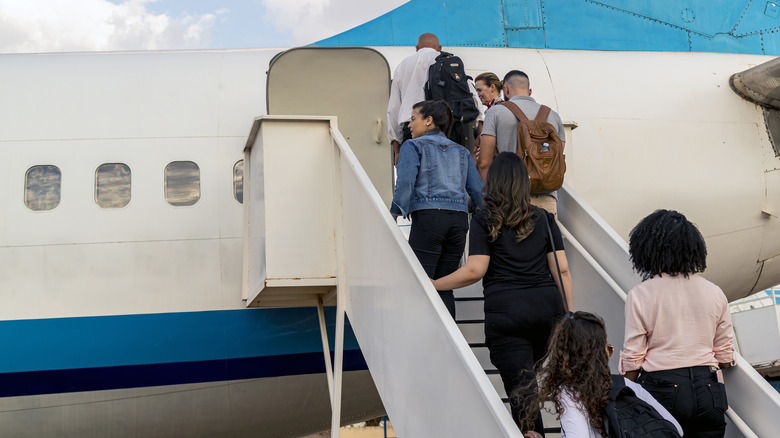Are You Allowed To Bring Oxygen Through TSA And On A Plane?
Since the COVID-19 pandemic, friction between airline workers and passengers has peaked. Shocking plane freakouts have gone viral, people have posted public complaints about not getting their way on a flight, and — understandably — flight attendant morale has fallen to an all-time low. However, airlines certainly aren't always right, and sometimes, traveler outrage appears to be completely justified, such as in one TikTok posted by @briellasmum.
In the clip, the content creator can be seen carrying her crying toddler through the airport after being barred from boarding a flight. "Thank you Spirit flight attendants for harassing me and kicking me and my daughter off our flight home because they wouldn't allow her oxygen!" reads the text on the video. The TikToker added in the caption that Spirit Airlines knew she would be traveling with oxygen, yet they still decided at the last minute to prevent her from flying.
@briellasmum No flights til tmr morning- and yes they knew we were boarding with oxygen #spiritairlines #fy #spirit #southcarolina #boston #flightattendant #foryou #thanks
People shared their support and shock in the comments, and the clip has garnered attention. According to the Transportation Security Administration (TSA), oxygen cylinders are permitted through airport security checkpoints but aren't allowed on planes. With that said, there's another way travelers, including @briellasmum, can access medically necessary oxygen on board.
Portable oxygen concentrators are allowed on planes
In a follow-up video, @briellasmum confirmed that she didn't try to bring personal oxygen cylinders on her Spirit flight. Rather, she had a rented portable oxygen concentrator that was approved by the airline and the Federal Aviation Administration (FAA). Portable oxygen concentrators are small machines that purify the air on the plane rather than storing supplemental oxygen. TSA says these devices are allowed in both plane cabins and checked luggage as long as the model meets the FAA's specifications.
There are a few points to keep in mind before traveling with a portable oxygen concentrator. First, each airline has its own list of approved models, and there may be certain rules about when you're allowed to use the device on board. Moreover, you can't just walk onto the plane with a portable oxygen concentrator without notifying the carrier. Contact the airline in advance (as soon as you book your tickets is best — in case you need to rent a particular machine) about your intention to fly with an oxygen concentrator.
Though your airline may not require it, consider getting a doctor's note to prove your device is required for medical reasons. Doing so can strengthen your request. Additionally, be sure you understand how the device works, including how often to charge the batteries to ensure it works throughout your journey.
Why travelers can't bring oxygen tanks on flights
There are plenty of unexpected items that can't go in your carry-on, including oxygen. Oxygen may seem harmless — after all, we need it to breathe — but a tank of the invisible substance can become dangerous once it's in the air (no pun intended). Oxygen cylinders are deemed hazardous by the FAA due to their flammability. If the tanks aren't handled carefully, or if something goes awry during a flight, they could explode.
Stored oxygen also isn't the most practical choice for fliers who need the substance for medical reasons. Tanks only have a limited supply of oxygen, meaning you might need to pack several canisters for long flights. Before the days of portable oxygen concentrators, airlines would sometimes sell oxygen cylinders to ensure those who needed it never ran out. With the range of devices on the market now, however, oxygen service is no longer necessary for most passengers.


